Metabolomics and gene expression levels reveal the positive effects of teaseed oil on lifespan and aging process in Caenorhabditis elegans
2023-01-03YananWangJiachenShiKunLiuYuWangYongjiangXuYuanfaLiu
Yanan Wang, Jiachen Shi, Kun Liu, Yu Wang, Yongjiang Xu, Yuanfa Liu*
State Key Laboratory of Food Science and Technology, National Engineering Research Center for Functional Food, National Engineering Laboratory for Cereal Fermentation Technology,Collaborative Innovation Center of Food Safety and Quality Control in Jiangsu Province, School of Food Science and Technology, Jiangnan University, Wuxi 214122, China
Keywords:Caenorhabditis elegans Lipids Lifespan Food omics Gene expression
A B S T R A C T As an irreplaceable dietary constituent, lipids play a vital important role in health, but their effects on aging process and longevity are still not well known yet. In this paper, the metabolic prof iling and gene expression levels of Caenorhabditis elegans were investigated to explore the effects of different edible oils on senescence and lifespan. The results showed that teaseed oil (TO) could prolong the life expectancy and slow down the aging process of C. elegans. Compared to the control group, the intake of lard oil (LO) and TO increased the expression levels of genes related to inhibition of protein aggregation (akt-1, daf-16, hsf-1, hsp-16.2) and lipid metabolism (daf-7, daf-1, mdt-15, lipl-4, fat-5, fat-6, fat-7), with a more significant alteration in TO group. Metabolomics revealed that palm oil can upregulated plenty of fatty acids (palmitic acid, stearic acid,tetracosanoic acid), together with some amino acids (tryptophan, L-aspartate, L-valine) and carbohydrate(D-glucose), while the trend was opposite in TO group. Besides, moderate-to-strong correlations were found between differential metabolites and changed genes. In general, this paper claimed that TO could prolong lifespan and slow down aging process via regulating the lipids, amino acids and carbohydrates metabolism.
1. Introduction
Dietary lipids play an important role in human health because of their multiple functions, they can promote the absorption of fat-soluble vitamins, provide energy and essential fatty acids (FAs)for human body [1]. Incontrovertibly, the intake of different dietary oils may cause different effects on human health [2-7]. Palm oil (PO)has been used as frying oil globally, since it has a high content of saturated FA (SFA), which is relatively stable and will not be easily oxidized during long time [8,9]. However, several studies reported that daily consuming of long chain SFAs might induce the expression of inflammatory cytokines, profoundly leading some metabolic diseases [10,11]. Lard oil (LO) is a traditional dietary lipid in China,it is welcome in some region since it has a lower price, unique aroma and f lavor [12,13]. For the similar reasons with PO, LO is not recommended for daily use and regarded as “unfriendly lipid” for human [2,14], but there are some papers claimed that LO is suitable for making blend oil because it has a wide range of FAs and the contents are balanced [15]. Recently, teaseed oil (TO) becomes one of the most popular vegetable oils since it is rich in unsaturated FAs (UFAs) such as oleic acid and linoleic acid [16], these UFAs might alleviate the progression of Alzheimer’s disease and liver f ibrosis [17,18].
It is proven that dietary lipids could influence the lifespan and aging process of human [19]. Aging is a multifarious process affected by genes, living standards and many other external conditions [19].The pathways associated with longevity are intricate and many researches have confirmed that dietary lipid constitution has a strong impact on lifespan and aging process [20]. For example,oleic acid, belonging ton-9 FA family, is available to enhance lifetime via NHR-49/PPARα, oxidation to oxylipins, deficiency of H3K4me3 methyltransferase and activation of autophagy [21-23]. A study insinuated alloaromadendrene extracted fromCinnamomum osmophloeumleaves extends lifetime ofCaenorhabditis eleganson account of oxidative stress resistance [24]. The consumption ofSalvia hispanicaL. seed oil and coix seed oil can produce anti-stress ability and modulate lipid accumulation ofC. elegans[25,26].Polyunsaturated FAs are pointed out as essential ingredients for neurotransmission inC. elegans, and they can regulate lipid homeostasis through insulin signaling pathway (IIS) [27,28].However, the effects of PO, LO and TO on lifespan and the mechanisms are unclear yet.
As one of the high-throughput omics technologies, metabolomics is able to excavate molecular metabolites changed by dietary meals and external environment in cells, organs, tissues and other kinds of biological samples [29,30]. As an important tool of food-omics,metabolomics could speculate the relationship between variables and metabolite differences so as to find out the effects of variables on the metabolism of the body [31,32]. In food science area, the metabolome includes varieties of compounds that changed by dietary intake, many subfields including food quality analyses, food processing, food safety control and food nutrition have received a great boost because of this strong technique [33,34]. It is a technology that can help us to establish a link between diet and health to understand the impact of food and how to prevent diseases and stay healthy through diet [35].
Meanwhile,C. elegansis a simple multicellular model animal for investigating the effects of lipids in disease conditions and aging; it is easy to operate, and has highly conserved genes with human and a short life cycle [20,36]. A large number of studies concentrated on the stress response ofC. elegansand its relevance with obesity, Parkinson and nervous system diseases using metabolomics [26,37-39]. Besides,this kind of transparent, short-lived worm serves as a model organism to explore new drug delivery systems and evaluate toxicological effects,providing a valid platform to understand human diseases [39-45].
In this paper, the effects of different dietary oils on aging process and lifespan ofC. eleganswere studied, the links between lipids and aging, and the differential metabolites caused by dietary oils ingestion were also investigated by metabolomics methodology(liquid chromatography-mass spectrometry (LC-MS) and gas chromatography-mass spectrometry (GC-MS)). On the other hand,shifty genes were screened out and quantified based on quantitative polymerase chain reaction (qPCR). The connections within genes and differential metabolites were uncovered and the results implied that different edible oils can change the gene expressions and endogenous metabolites inC. elegansdiversely, the underlie mechanisms should be lipid, amino acid, carbohydrate and purine relevant metabolism pathways.
2. Materials and methods
2.1 Materials
Edible oils were purchased from China Oil and Foodstuffs Corporation (COFCO, Beijing, China). The reduced glutathione(GSH) assay kit and triglyceride (TG) assay kit were purchased from Nanjing Jiancheng Bioengineering Institute (Nanjing, China). The MolPure®TRIeasy Plus Total RNA kit, Hifair®III 1stStrand cDNA Synthesis SuperMix for qPCR and Hieff qPCR SYBR Green Master Mix were provided by Yeasen Biotech Co., Ltd. (Shanghai, China).C. elegansandEscherichia coliOP50 were generously given by Professor Xiulan Sun (Jiangnan University, China). Acetonitrile,pyridine, ammonium acetate and other chromatographic reagents were obtained from Thermo Fisher Scientific (MI, USA). Analytical grade chemicals were provided by Sinopharm Chemical reagent Co., Ltd.(Shanghai, China). All solutions were prepared freshly before use and Milli-Q Direct 8 system (Millipore Corp., Bedford, MA, USA) was used to provide water.
2.2 C. elegans maintenance
C. eleganswere incubated in Nematode Growth Medium(NGM) plates (diameter = 60 mm), which contained 10 μmol/L 5-fluoro-2’-deoxyuracil (FUDR), at 20 °C. As the food source,E. coliOP50 was provided with or without 5 mg oil-in-water (O/W) emulsions per plate.
2.3 Physiological indexes of C. elegans
Synchronized worms were used to determine all experimental indicators and each group had 3-5 biological replicates. For lifespan assay, all worms were checked daily for dead, the dead were recorded and removed until all worms were dead. In the motor ability assessment, at least 120 worms (3 replicates, 40 in each replicate group) were selected to determine the head swing and body bend frequency at day 10. TG content was determined by kit and characterized by Oil Red O staining at day 10. In Oil Red O staining experiment, worms were washed by M9 buffer for 3 times before adding Oil Red O solution (5 g/L in 60% isopropanol) for staining.After 30 min, the stained worms were washed using M9 buffer for 3 times and photographed by polarization microscope (DM2700P,Leica, Germany) with a camera (DFC450, Leica, Germany).
2.4 Gene expression analysis
mRNA was extracted by MolPure TRIeasy Plus Total RNA kit,the concentration and purity of mRNA were tested by Ultramicro spectrophotometer and the reverse transcription of mRNA was performed according to the instructions of the Hifair®III 1stStrand cDNA Synthesis SuperMix. Real-time qPCR was performed according to the instructions of Hieff qPCR SYBR Green Master Mix kit andact-1gene was used as the internal reference. The data were processed based on the 2-△△CTthreshold cycling method to calculate the relative gene expression levels. The primers were designed and synthesized by Sangon Biotech (Shanghai, China), and their sequences are shown in Table S1.
2.5 Sample preparation of mass spectrometry
A freeze dryer (Xianou-12N) was used to prepare initial worm samples at -85 °C and 200 μL cold methanol containing an internal standard (10 μg/mL Fmoc-glycine) was added into each 2 mg powder sample. All worm solutions were vortexed for 30 s and ultrasonicated for 5 min (50 Hz, 4 °C), 160 μL supernatant was collected from the centrifuged (20 000 ×g, 10 min, 4 °C) mixture, following with rotary evaporation (V-AQ, 30 °C, 6 h). The rotary evaporation was operated by concentration plus system (Eppendorf, Germany). After drying, 200 μL cold methanol containing an internal standard was used to redissolved samples following with centrifugation (15 000 ×g,10 min, 4 °C). 80 μL supernatant from the above samples was taken for LC-MS and 100 μL supernatant was taken for further treatment for GC-MS. In GC-MS sample preparation, 100 μL supernatant was dried using the rotary evaporation (V-AQ, 30 °C) for 2 h,70 μL methoxyamine pyridine solution (50 μg/mL) was added into the drying samples and stored at 37 °C. After 2 h, 70 μLN-methyl-N-(trimethylsilyl) trifluoroacetamide (MSTFA) was added into the former solutions and stored at 37 °C for another 16 h. The solutions were centrifuged (20 000 ×g, 10 min, 20 °C) and 100 μL supernatant was collected for GC-MS.
2.6 LC-MS analysis
Samples were analyzed by a TRIPLE TOF 5600+system (AB SCIEX, USA) with an electrospray ionization (ESI) source. A Hypersil GOLD column (100 mm × 2.1 mm, 1.9 μm; Thermo Fisher Scientific, USA) or an ACQUITY UPLC®BEH Amide column(2.1 mm × 100 mm, 1.7 μm; Waters Corporation, USA) was employed to prepare samples, the mobile phases A (water with 0.1% ammonium acetate) and B (acetonitrile) were used in both positive and negative mode. The sample injection volume was 2 μL. For Hypersil GOLD column, the elution program was: 0-2 min, 0-5% B; 2-3 min,5%-40% B; 3-6 min, 40%-70% B; 6-18 min, 70%-100% B; 18-20 min,100% B; 20-21 min, 100%-5% B; and 21-23 min, 5% B, with a flow rate of 0.3 mL/min. The elution program for ACQUITY UPLC®BEH Amide column was: 0-1 min, 85% B; 1-12 min, 85%-65% B; 12-15 min,40% B; and 15-20 min, 85% B, with a flow rate of 0.3 mL/min.The mass range wasm/z25-1 000 and the temperature of ion source heater was 550 °C for all modes. Nitrogen was applied as curtain gas(207 kPa), the ion source gas (345 kPa) and the ion spray voltages were 5.5 kV at positive mode or -4.5 kV at negative mode.
2.7 GC-MS analysis
Samples were analyzed by GCMS-QP2020 system with a batch autosampler system. 1 μL aliquot of sample was injected into the HP-5MSI column and the injection port temperature was 250 °C. The flow rate of helium was 1.0 mL/min as a carrier gas. At the beginning,the column temperature rose steadily from 70 °C to 250 °C with a rate of 10 °C/min. In the next step, the temperature was pumped to 300 °C at a rate of 25 °C/min and then retained for 5 min. An ion source with a selective detector was utilized to analysis the effluent. The delivery temperature was 280 °C, the ion source temperature was 230 °C and all data were fully scanned with a scope ofm/z50-550 under 70 eV electronic shock mode.
2.8 Data processing
Data processing methods were based on our pervious method [35].In brief, the original data of LC-MS and GC-MS were converted into mzData format before loading to MZmine 2.53 for baseline corrections, peak detection and data normalization. The vacant values were filled with half of the minimum value in each dataset.
2.9 Statistical analysis
The above processed data were multivariate analyzed(principal component analysis (PCA) and orthogonal partial least squares-discriminant analysis (OPLS-DA)) and the variable importance in the projection (VIP) values were selected by SIMCA-P version14.1.One-way ANOVA analysis, student’st-test and the spearman bivariate correlate analysis were performed through SPSS version 20,P-values less than 0.05 were identified as significant. The results were reported as mean ± standard error. Metabolites were identified by MetDNA and built-in database. Heatmaps were drew by R-project and pathway enrichment was processed using MetaboAnalyst 5.0 and Kyoto Encyclopedia of Genes and Genomes (KEGG) database. The correlation analysis was preformed through Cytoscape 3.8.2.
3. Results
3.1 Effects of edible oils on lifespan, motor ability and other physiological indexes of C. elegans
Five micrograms O/W emulsions of different oils were prepared forC. elegansculturing to explore the effects of oils on lifespan and aging process. As shown in Figs. 1A and B, the consumption of PO and LO had no significant impacts on lifespan ofC. elegans, while the lifespan in TO group was prolonged up to (18.34 ± 0.55) days. As indicators for aging, head swing and body bend were selected based on previous study [46]. As shown in Figs. 1C and D, PO reduced the motor ability ofC. eleganssignificantly, while TO group showed the opposite trend. Interestingly, almost no difference was found in LO group compared to Tween 80 (Tw 80) control group. Also, the intakeof all kinds of oils can increase the level of GSH in C. elegans and the value in TO group is notably (Fig. 1E). As shown in Fig. 1F, PO and LO groups exhibited a significant increase of TG content. However,the intake of TO could control the increasing trend of TG content in C. elegans and the photomicrographs in Oil Red O staining experiment confirmed the results (Fig. S1).

Fig. 1 Effects of different dietary oils on physiological conditions of C. elegans. (A) Survival curves, (B) average lifespan, and motor ability ((C) head swing and (D) body bend frequency) analysis of C. elegans altered by different dietary oils ingestion at 20 °C. (E) Glutathione levels quantified by relative fluorescence intensity at 405 nm. (F) Relative TG content of C. elegans treated with different dietary oils after 10 days. The different lowercase letters above the bar graphs represented the significant difference of different oil groups (P < 0.05).
3.2 Effects of oils on gene expression levels
The effects of different oils on the genes involved in C. elegans were evaluated by qPCR. As depicted in Fig. 2, with the ingestion of oils, the downregulation of daf-2, upregulation of akt-1, daf-16, hsf-1,hsp-16.2 (key genes related to inhibition of protein aggregation) and target genes (daf-7, daf-1, mdt-15, sbp-1, lipl-4, fat-5, fat-6, fat-7)related lipid metabolism were observed. Among them, TO had the most obvious effects on the above genes while PO had the least effects.
3.3 Multivariate analysis of metabolic profiling by LC-MS and GC-MS
The metabolic profiles of C. elegans treated with different oils were revealed by LC-MS and GC-MS. The OPLS-DA cluster analysis(Fig. S3) displayed that there existed significant separations between each group, with strong modeling fit R2Y values of 0.998 (LC-MS),0.677 (GC-MS), as well as good prediction Q2values of 0.296(LC-MS), 0.549 (GC-MS). Heatmaps were demonstrated among 109 potential biomarkers, including 28 lipids (Fig. 3A), 41 amino acids(Fig. 4A), 11 carbohydrates and some other compounds related to purine metabolism (Fig. 5A). Fig. 3C indicated that various FAs like stearic acid, palmitic acid, tetracosanoic acid increased in PO group,while almost all kinds of FAs (e.g. oleic acid, stearic acid, palmitic acid, α-linolenic acid, arachidonic acid) showed a decline trend in TO group. Similarly, some amino acids such as L-aspartate, L-valineincreased in PO group, many key amino acids (tryptophan,L-tyrosine,L-threonine,L-proline) decreased in TO group (Fig. 4C). However,these above substances remained unchanged or slightly reduced in LO group. Fig. 5C discovered that the intake of oils could lead a higher content of carbohydrate (D-glucose) and a lower content of purine metabolites (guanine, urea, allantoin) inC. elegans, no matter about the oil types. Additionally, top 25 metabolic pathways enriched by the 109 differential metabolites and their scores were exhibited in Fig. S4, the primary pathways could be summarized into lipid metabolism, amino acid metabolism, carbohydrate metabolism, purine metabolism and their relevant pathways.

Fig. 2 (Continued)
3.4 Correlations analysis between metabolic alterations and gene expression levels
The correlations among differential metabolites and gene expressions were investigated. As shown in Fig. 3B, key genes in lipid metabolism (daf-1,daf-7,mdt-15,sbp-1,lipl-4,fat-5,fat-6,
fat-7) had negative correlations with palmitic acid, oleic acid,arachidonic acid, stearic acid, vaccenic acid, myristic acid andα-linolenic acid. Apart from that,daf-2was inversely associated withL-serine,L-lysine, spermidine and existed a positive correlation with biotin,L-threonine and ophthalmic acid, whilehsf-1showed the opposite tendency (Fig. 4B). In addition, positive connections betweenD-glucose andsod-3,hsf-1,hsp-16.2,akt-1, a negative connection withdaf-2were illustrated in Fig. 5B.
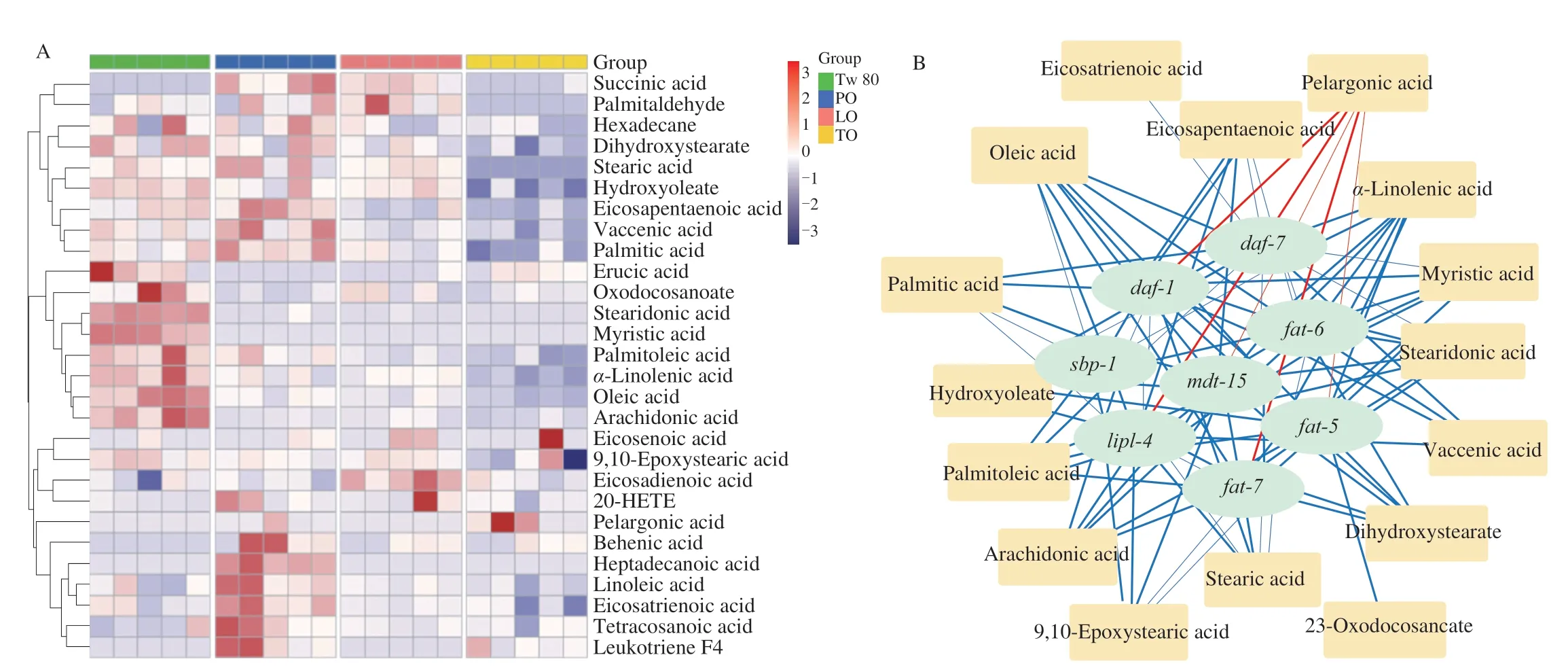
Fig. 3 Effects of different oils on C. elegans from lipid metabolites perspective. (A) Heatmap of differential metabolites in lipid metabolism of different groups.The column lines represent group information and the row lines reflect metabolites. Red grids, white grids and blue grids show an increase up to fourfold, no significant and a decrease up to fourfold changes. (B) Correlation analysis between lipid metabolites and related gene expressions. Spearman bivariate correlate analysis was exhibited between differential metabolites and gene expression levels. The lines mean a relation between metabolites and genes, the color portends a positive (red) and a negative (blue) association and the width displays the strength of relevance. The round rectangle shape states metabolites in lipid metabolism pathway (yellow); the circle shape represents target genes (green). (C) Lipid metabolism pathways changes in C. elegans under different oils intake. Different colors demonstrate various pathways and their related metabolites. Box plots show the metabolites variations in different groups. Same as in Figs. 4 and 5.
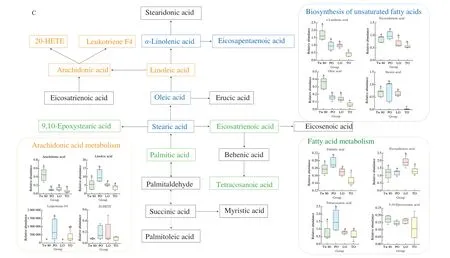
Fig. 3 (Continued)

Fig. 4 Effects of different oils on C. elegans from amino acid metabolites perspective. (A) Heatmap of differential metabolites in amino acid metabolism of different groups. (B) Correlation analysis between amino acid metabolites and related gene expressions. The round rectangle shape states metabolites in amino acid metabolism pathway (yellow). (C) Amino acid metabolism pathways changes in C. elegans under different oils intake.
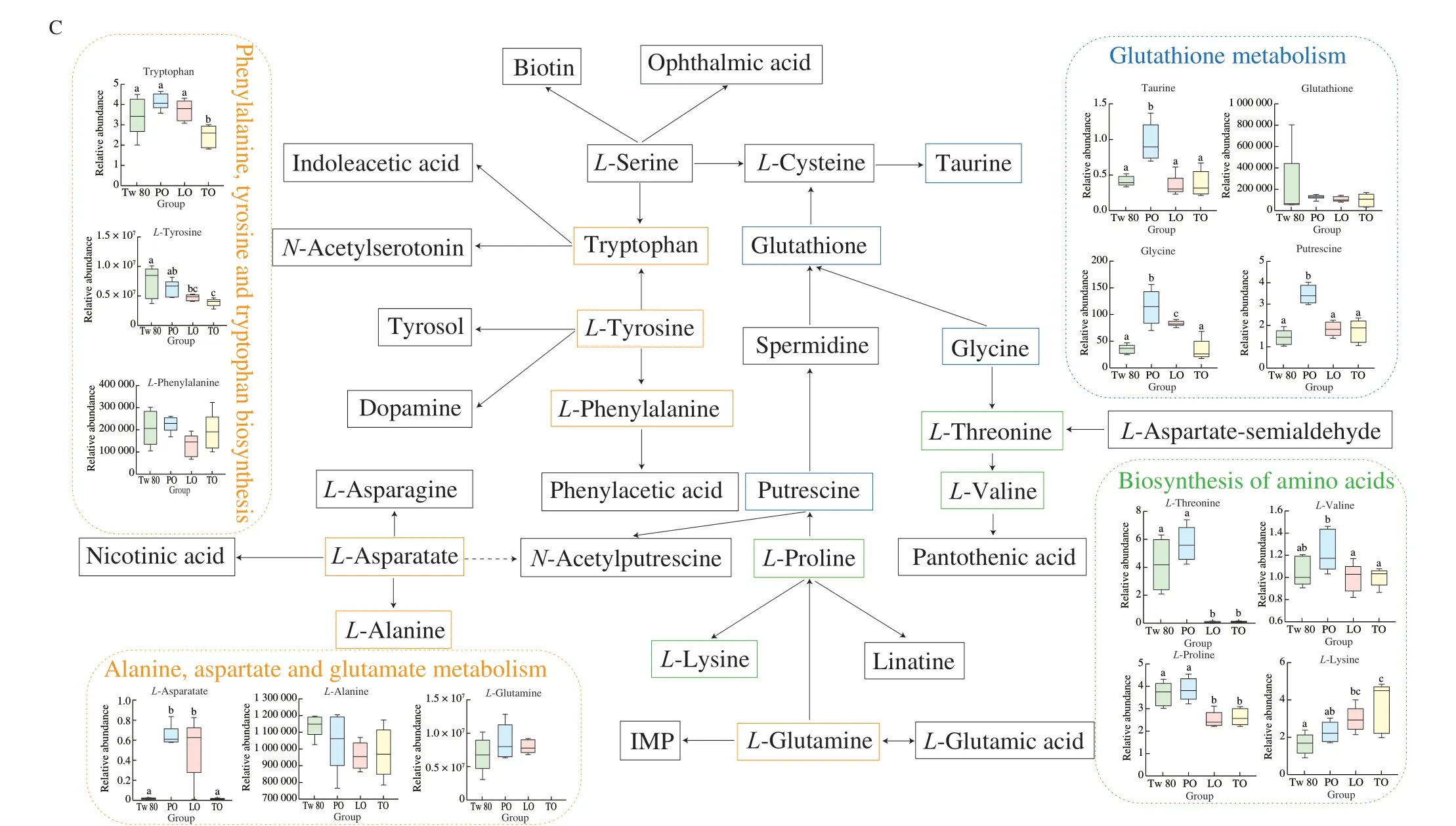
Fig. 4 (Continued)
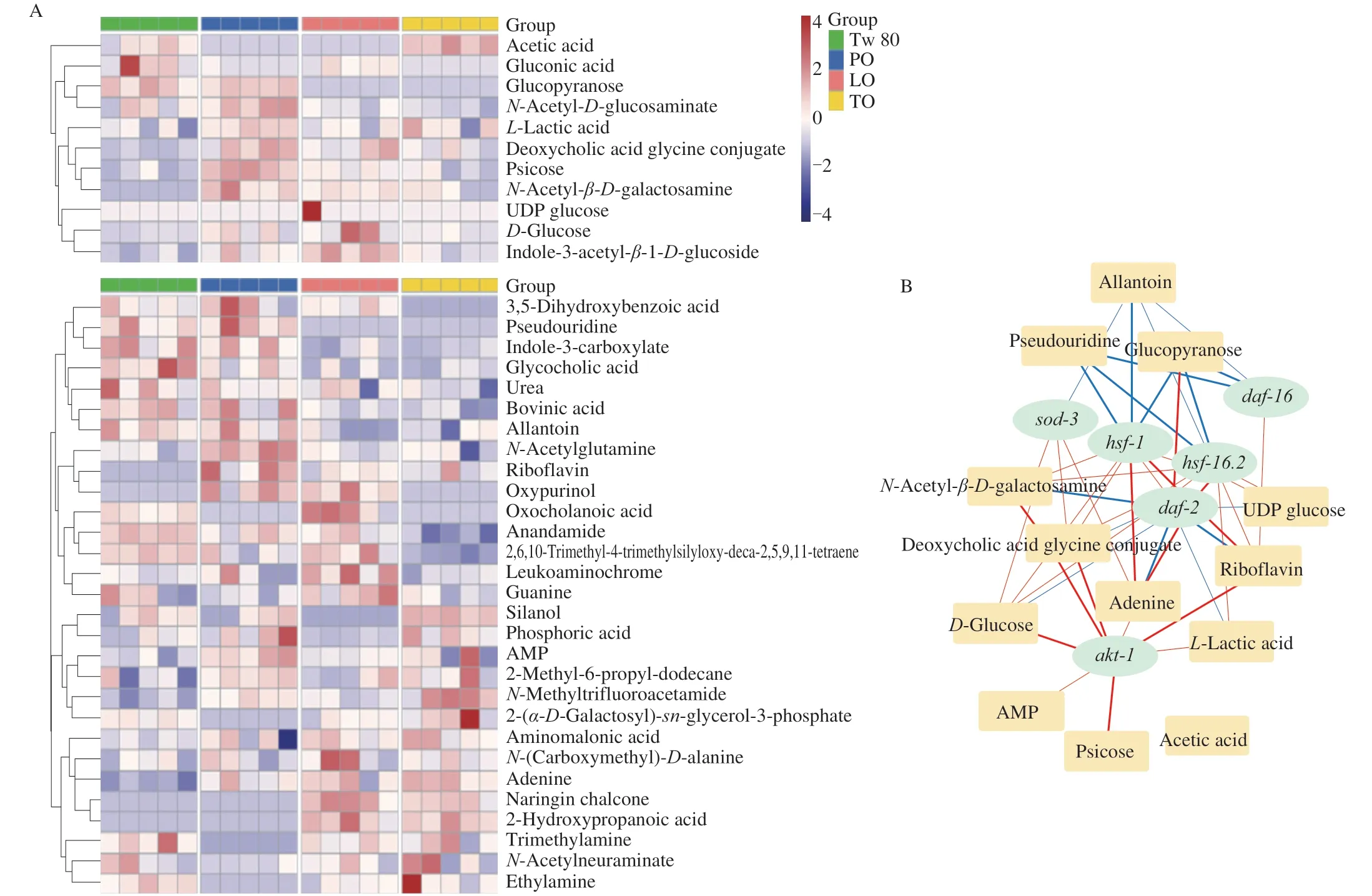
Fig. 5 Effects of different oils on C. elegans from carbohydrate and purine metabolites perspective. (A) Heatmaps of differential metabolites in carbohydrate metabolism, purine metabolism and other metabolism pathways of different groups. (B) Correlation analysis between carbohydrate metabolites, purine metabolites and its related metabolites and target gene expressions. The round rectangle shape states metabolites in carbohydrate metabolism pathway (yellow).(C) Carbohydrate metabolism, purine metabolism and its related metabolism pathways changes in C. elegans under different oils intake.
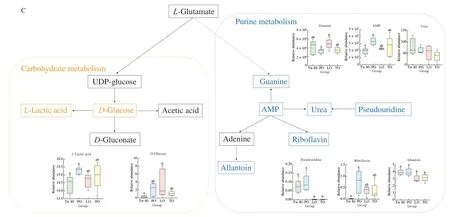
Fig. 5 (Continued)
4. Discussion
Numerous studies have focused on the effects of different oils on health and diseases of human [6,26,38,47,48]. However, few are dedicated to lifespan and aging process of PO, LO and TO. Here, we found that the consumption of PO had adverse effects, appropriate intake of LO had no major impact on health and TO is benefit for slowing aging and longevity.
As shown in Figs. 1A-D, PO led a shorten lifespan ofC. elegansafter the whole lifetime exposure, the motor ability was also weakened at day 10, the results are consistent with Shmookler Reis et al. [49].The ingestion of palmitic acid, which is the dominant FA in PO, could generate multiple adverse effects on human health, including some inflammatory diseases like inflammatory bowel disease (IBD) and further influence living quality [6], so it is not surprise that the intake of PO could slow down the exercise capacity and shorten the lifetime ofC. elegans. Inversely, the lifespan in TO group was prolonged to an average of (18.34 ± 0.55) days, compared with (16.56 ± 0.49) days in Tw 80 control group. The head swing and body bend frequency,which are recognized as the evaluation indexes of aging process, were also increased at day 10. TO is a pure natural woody edible vegetable oil; it contains high level of UFA and monosaturated FA (oleic acid)occupies about 82% [50]. Several papers highlighted the benefits of TO, which could modify gut microbiota, alleviate colitis, attenuate non-alcoholic fatty liver disease because of its antioxidant and anti-inflammatory properties [3,51-53]. As the most abundant FA in TO, oleic acid is also reported many advantages on health; it has been shown to improve insulin sensitivity, prevent the proliferation of cancer cells and reduce the production of proinflammatory [26,54].A specific enrichment of oleic acid is proven to extend the lifespan ofC. elegans[22]. Surprisingly, even it has relative high content of SFAs, LO did not have major influence on lifespan and motor ability ofC. elegans, the reason might be its rich types of FAs and balanced content, the moderate consumption of LO would not affect health severely.
During the aging progress ofC. elegans, GSH and TG content are two evaluation indicators to estimate the aging level. As expected,PO and LO showed small but not significant increase of GSH levels,notable enhancement of GSH was observed in TO group (Fig. 1E).The improvement of GSH in varying degrees reflected that oil intake could increase the oxidation resistance ofC. elegansand oleic acid in TO might pose the most significant influence. Oleic acid is a regulator in mitochondrial and endothelial functioning against diabetes [55];it can reverse hepatic steatosis and oxidative damage since its radicals scavenging activity [56,57]. In TG content determination, PO and LO increased TG inC. eleganssignificantly after 10 days exposure, while TO had no obvious impacts (Fig. 1F). In fact, the fat accumulation is another contributor for life-extending and it often companies with the increase of stress resistance, but it is not necessary for longevity [22,58,59].
There are many confirmed pathways connecting with aging and lifespan inC. elegans. As shown in Fig. 2, the downregulation ofdaf-2,the upregulation ofakt-1,daf-16,hsf-1,hsp-16.2in IIS, and the upregulation ofdaf-7,daf-1,mdt-15,sbp-1,lipl-4,fat-5,fat-6,fat-7in lipid metabolism pathways were uncovered with the treatment of oils, TO had the greatest effects, followed by LO. Based on these changed genes, LC-MS and GC-MS were used to identify differential metabolites response to different dietary oils supplement. A total of 109 differential metabolites were screened out and as shown in Fig. S4, top 25 enrichment pathways were displayed according to the original data in Table S2, the main pathways (P< 0.05) includingD-glutamine andD-glutamate metabolism, biosynthesis of UFAs,alanine, aspartate and glutamate metabolism and other pathways in lipid metabolism, amino acid metabolism and carbohydrate metabolism. What is more, spearman bivariate correlate analysis between differential metabolites and gene expressions were displayed and the relative coefficient (R-value) andP-value can be found in the supporting information (Tables S3-S6).

Fig. 6 Roles of genes in controlling lifespan of C. elegans. Intake of different dietary oils can activate or inhibit a cell membrane protein, daf-2, it will regulate akt-1 then sequentially negative control the expression of daf-16. As one of the most important gene in lifespan control, daf-16 could activate its multiple downstream genes like hsp-16.2, sod-3, lipl-4, they will regulate lifetime of C. elegans through inhibition of protein aggregation, stress resistance and lipolysis pathway. Meanwhile, daf-16 might have indirect influence on lipid metabolism through a key gene nhr-80. Additionally, sbp-1 is a homologous gene in C. elegans as SREBP, it can regulate genes of lipogenesis. As an activator, mdt-15 can mutual adjust lipid metabolism with sbp-1 and positive regulate its target downstream genes (fat-5, fat-6, fat-7). daf-7 is a transforming growth factor, it also regulates fat-5, fat-6, fat-7 by irritate daf-1.
In lipid metabolism pathways, the differential metabolites involved 28 lipids. Thereinto, several FAs (stearic acid, palmitic acid,tetracosanoic acid) increased in PO group, while oleic acid, stearic acid, palmitic acid,α-linolenic acid, and arachidonic acid showed a decline trend in TO group, which is shown in Fig. 3A. These lipid metabolites did not change significantly or just illustrated a slightly decrease in LO group. The connections within lipids were illustrated through KEGG database (Fig. 3C) and the relationships between these metabolites and related genes were discovered (Fig. 3B). As shown in Fig. 6, SREBP is the main transcriptional regulator in mammals and it can regulate the expression of adipogenic genes.sbp-1is the homologous gene of SREBP inC. elegans, which maintains the cholesterol and fat homeostasis. As an agonist ofsbp-1,mdt-15can participate in the regulation of lipid metabolism after binding to the activation domain ofsbp-1and activate the downstream genes (fat-5,fat-6,fat-7). InC. elegans,fat-5,fat-6andfat-7are responsible for the synthesis of FA desaturase, so the upregulation of these genes could guarantee a higher content of UFAs. Meanwhile, DAF-7 is a ligand of transforming growth factor-β (TGF-β), which is expressed in ASI neurons and takes participate in regulating the lipid metabolism and growth ofC. elegans. The TGF-β ligand DAF-7 is encoded bydaf-7,anddaf-1encodes the type I receptor DAF-1 of TGF-β. Whendaf-1anddaf-7are mutated or their expression is inhibited, lipid accumulation will promote inC. elegans[60]. Generally speaking,lipids accumulation always along with the production of reactive oxygen species, which is harmful to health [25]. Moderate-to-strong connections between target lipid metabolism genes and 16 lipid metabolites are side evidences that the intake of TO could decrease the synthesis of lipids inC. elegansand ensure a long life.
Also, amino acids changed a lot inC. elegans(Fig. 4A) with different oils feeding. Many amino acids likeL-aspartate,L-valine increased in PO group, key amino acids (tryptophan,L-tyrosine,L-glutamine,L-threonine,L-proline) in amino acid metabolism pathways decreased in TO group, and most differential amino acids stated unchanged in LO group (Fig. 4C). Through KEGG database,it is proof that the decrease of amino acids may pose indirect associations to carbohydrate and purine metabolism pathways and then generate remote-effects on longevity. The mechanisms at the genetic level were illustrated in Fig. 6,akt-1is regulated bydaf-2, a key gene in IIS and further negative regulate the expression ofdaf-16, which can activate downstream genes (hsp-16.2,sod-3,lipl-4)expression thus achieve longevity. Among them,hsp-16.2is an inhibitor of protein,sod-3can improve the stress resistance andlipl-4is responsible for lipolysis [61,62]. A negative connection betweendaf-2andL-serine,L-lysine, spermidine, a positive correlation with biotin,L-threonine and ophthalmic acid proved the reduction of amino acids inC. eleganshas a bearing on lifespan and aging process since the downregulation ofdaf-2(a key gene in IIS) is a guarantee for a long life (Fig. 4B). Additionally,nhr-80(an upstream gene offat-5,fat-6andfat-7) have a remote effect withdaf-16.
Besides, a higher content of carbohydrate (D-glucose) and a lower content of purine metabolites (guanine, urea, allantoin) were revealed inC. elegansconducted with edible oils, no matter about the oil types(Fig. 5A). Carbohydrate metabolism and purine metabolism pathways were connected byL-glutamate and pose indirect effects on lifespan(Fig. 5C).D-glucose is served as the most important metabolite in carbohydrate metabolism, which exerts positive connections withsod-3,hsf-1,hsp-16.2,akt-1and negative connection withdaf-2(Fig. 5B).
In conclusion, the ingestion of PO was regarded has negative effects on aging progress, TO has advantages in reducing lipid accumulation, increasing oxidative resistant and then prolonging the lifespan, while moderate intake of LO did not show strong influences neither in aging process nor lifetime. Mechanically, lipid metabolism,amino acid metabolism, carbohydrate metabolism, purine and its related metabolism were the curial pathways under the circumstances.The relative expression levels of key genes in lipid and amino acid metabolism confirmed the results from metabolomics. In summary,the results from this study illustrated the relationships between edible oils and aging and offered a new insight on the roles of lipids on longevity.
Conflict of interest statement
The authors declare that they have no conflict of interest.
Acknowledgments
This work was supported by National Key R&D Program of China (2019YFC1606205), Natural Science Foundation of China(32172136), Jiangsu distinguished professor project and Talent plan of Taihu Lake.
Appendix A. Supplementary data
Supplementary data associated with this article can be found, in the online version, at http://doi.org/10.1016/j.fshw.2022.10.032.
杂志排行
食品科学与人类健康(英文)的其它文章
- Emerging natural hemp seed proteins and their functions for nutraceutical applications
- A narrative review on inhibitory effects of edible mushrooms against malaria and tuberculosis-the world’s deadliest diseases
- Modulatory effects of Lactiplantibacillus plantarum on chronic metabolic diseases
- The role of f lavonoids in mitigating food originated heterocyclic aromatic amines that concerns human wellness
- The hypoglycemic potential of phenolics from functional foods and their mechanisms
- Insights on the molecular mechanism of neuroprotection exerted by edible bird’s nest and its bioactive constituents
